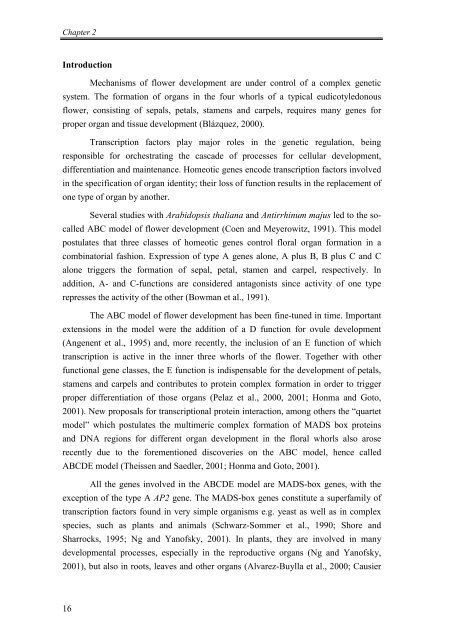Flower development of Lilium longiflorum - The Lilium information ...
Flower development of Lilium longiflorum - The Lilium information ...
Flower development of Lilium longiflorum - The Lilium information ...
Create successful ePaper yourself
Turn your PDF publications into a flip-book with our unique Google optimized e-Paper software.
Chapter 2<br />
Introduction<br />
Mechanisms <strong>of</strong> flower <strong>development</strong> are under control <strong>of</strong> a complex genetic<br />
system. <strong>The</strong> formation <strong>of</strong> organs in the four whorls <strong>of</strong> a typical eudicotyledonous<br />
flower, consisting <strong>of</strong> sepals, petals, stamens and carpels, requires many genes for<br />
proper organ and tissue <strong>development</strong> (Blázquez, 2000).<br />
Transcription factors play major roles in the genetic regulation, being<br />
responsible for orchestrating the cascade <strong>of</strong> processes for cellular <strong>development</strong>,<br />
differentiation and maintenance. Homeotic genes encode transcription factors involved<br />
in the specification <strong>of</strong> organ identity; their loss <strong>of</strong> function results in the replacement <strong>of</strong><br />
one type <strong>of</strong> organ by another.<br />
Several studies with Arabidopsis thaliana and Antirrhinum majus led to the so-<br />
called ABC model <strong>of</strong> flower <strong>development</strong> (Coen and Meyerowitz, 1991). This model<br />
postulates that three classes <strong>of</strong> homeotic genes control floral organ formation in a<br />
combinatorial fashion. Expression <strong>of</strong> type A genes alone, A plus B, B plus C and C<br />
alone triggers the formation <strong>of</strong> sepal, petal, stamen and carpel, respectively. In<br />
addition, A- and C-functions are considered antagonists since activity <strong>of</strong> one type<br />
represses the activity <strong>of</strong> the other (Bowman et al., 1991).<br />
<strong>The</strong> ABC model <strong>of</strong> flower <strong>development</strong> has been fine-tuned in time. Important<br />
extensions in the model were the addition <strong>of</strong> a D function for ovule <strong>development</strong><br />
(Angenent et al., 1995) and, more recently, the inclusion <strong>of</strong> an E function <strong>of</strong> which<br />
transcription is active in the inner three whorls <strong>of</strong> the flower. Together with other<br />
functional gene classes, the E function is indispensable for the <strong>development</strong> <strong>of</strong> petals,<br />
stamens and carpels and contributes to protein complex formation in order to trigger<br />
proper differentiation <strong>of</strong> those organs (Pelaz et al., 2000, 2001; Honma and Goto,<br />
2001). New proposals for transcriptional protein interaction, among others the “quartet<br />
model” which postulates the multimeric complex formation <strong>of</strong> MADS box proteins<br />
and DNA regions for different organ <strong>development</strong> in the floral whorls also arose<br />
recently due to the forementioned discoveries on the ABC model, hence called<br />
ABCDE model (<strong>The</strong>issen and Saedler, 2001; Honma and Goto, 2001).<br />
All the genes involved in the ABCDE model are MADS-box genes, with the<br />
exception <strong>of</strong> the type A AP2 gene. <strong>The</strong> MADS-box genes constitute a superfamily <strong>of</strong><br />
transcription factors found in very simple organisms e.g. yeast as well as in complex<br />
species, such as plants and animals (Schwarz-Sommer et al., 1990; Shore and<br />
Sharrocks, 1995; Ng and Yan<strong>of</strong>sky, 2001). In plants, they are involved in many<br />
<strong>development</strong>al processes, especially in the reproductive organs (Ng and Yan<strong>of</strong>sky,<br />
2001), but also in roots, leaves and other organs (Alvarez-Buylla et al., 2000; Causier<br />
16














